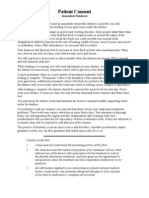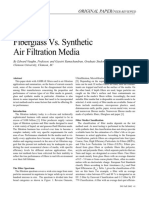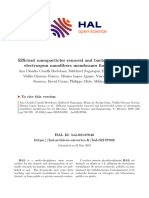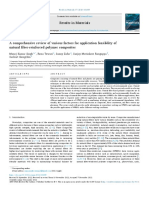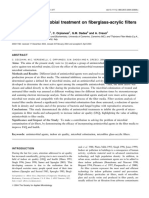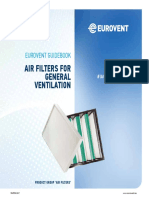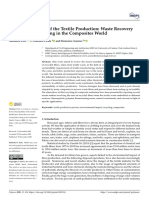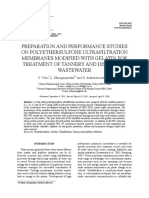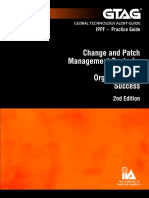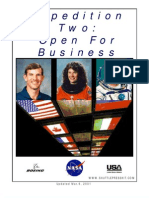Investigation of The Physical Properties of Meltblown Nonwovens For Air Filtration
Investigation of The Physical Properties of Meltblown Nonwovens For Air Filtration
Uploaded by
albertoCopyright:
Available Formats
Investigation of The Physical Properties of Meltblown Nonwovens For Air Filtration
Investigation of The Physical Properties of Meltblown Nonwovens For Air Filtration
Uploaded by
albertoOriginal Title
Copyright
Available Formats
Share this document
Did you find this document useful?
Is this content inappropriate?
Copyright:
Available Formats
Investigation of The Physical Properties of Meltblown Nonwovens For Air Filtration
Investigation of The Physical Properties of Meltblown Nonwovens For Air Filtration
Uploaded by
albertoCopyright:
Available Formats
(REFEREED RESEARCH)
INVESTIGATION OF THE PHYSICAL PROPERTIES OF
MELTBLOWN NONWOVENS FOR AIR FILTRATION
HAVA FİLTRASYONU AMACIYLA ERİYİK ÜFLEME (MELTBLOWN)
YÖNTEMİNE GÖRE ÜRETİLEN DOKUSUZ YÜZEYLERİN
FİZİKSEL ÖZELLİKLERİNİN İNCELENMESİ
Kerim DURAN1, Deniz DURAN2, Gülşah OYMAK1, Kevser KILIÇ1,
*
Ezgi ÖNCÜ1, Mehmet KARA1
1
Ege University, Department of Textile Engineering, İzmir, Turkey
2
Ege University, Emel Akın Vocational Training School, İzmir, Turkey
Received: 18.01.2013 Accepted: 11.02.2013
ABSTRACT
Textile filters are industrial textiles used in filtration applications. Among textile materials, especially nonwovens are suitable for
filtration applications, because of their complex structures and appropriate thickness. Nonwoven filters are used in various application
areas of technical textiles such as medtech, mobiltech, protech, packtech and hometech. Meltblown nonwovens are a unique class of
materials, characterized by high surface are, porosity, softness and absorbency due to their microstructure. In this study polypropylene
meltblown nonwovens were produced for the purpose of air filtration. Physical properties, namely thickness, basis weight, tensile
properties, air permeability, and fibre diameter of were measured and effect of various production parameters on the physical properties
of PP meltblown nonwovens were investigated and possibility for using such materials in air filtration was discussed.
Key Words: Textile filters, Nonwoven, Meltblown, Microfiber nonwoven, Polypropylene.
ÖZET
Tekstil filtreleri filtrasyon uygulamalarında kullanılan endüstriyel tekstillerdir. Tekstil malzemeleri arasında özellikle nonwoven
malzemeler kompleks yapıda olmaları ve uygun kalınlıklarda üretilebilmeleri bakımından filtrasyon uygulamaları için uygundur.
Nonwoven filtreler teknik tekstillerin tıbbi tekstiller, koruyucu tekstiller, paketleme tekstilleri ve ev tekstilleri gibi birçok alanında
kullanılabilmektedir. Meltblown nonwovenlar geniş yüzey alanı, gözeneklilik, yumuşaklık ve mikro yapılarından kaynaklanan
absorbanlık gibi özellikleri nedeniyle benzersiz malzemelerdir. Bu çalışmada, hava filtrasyonu alanında kullanılmak üzere polipropilen
meltblown nonwovenlar üretilmiştir. Bu malzemelerin fiziksel özellikleri ölçülerek, çeşitli üretim parametrelerinin PP meltblown
nonwovenların fiziksek özellikleri üzerine etkileri incelenmiş ve bu malzemelerin hava filtrasyonunda kullanılabilme olasılıkları
tartışılmıştır.
Anahtar Kelimeler: Tekstil filtreleri, Nonwoven, Meltblown, Mikrolifli nonwoven, Polipropilen.
*
Corresponding Author: Deniz Duran, deniz.duran@ege.edu.tr, Tel: +90 232 311 27 69, Fax: +90 232 339 92 22
1. INTRODUCTION using textile filters increases the purity textile filters application areas. Filters
of the product and efficiency of the can be produced from woven, knitted
Filtration can be defined as seperation
process, saves energy, enables the or nonwoven fabrics as well as
of one material from another (1,2). The
recycling of valuable materials and composite structures where different
main purpose of filtration is to increase
helps to decrease the environmental fabric types are combined (3).
the pureness of the filtered material.
pollution in many industrial processes.
Filtration process is used in many
Air filters, personal protective Filtration provides an important
industrial applications. Textile filters
equipments such as surgial masks and function in protecting life, materials,
are mostly used for solid-gas or solid-
gowns, oil and gas filters, filters used equipment and the environment (4).
liquid seperation (2). Seperation of
in waste water treatment and chemical Table 1 shows the segments and
solid particles from liquid or gas by
dye recycling plants are examples of subsegments of air filtration.
136 TEKSTİL ve KONFEKSİYON 23(2), 2013
Table 1. Major segments and subsegments of air filtration (4)
Air Filtration Segments Sub-segments
Building/indoor Air Quality Commercial, Residential, Institutional
Transportation Automotive, Heavy duty
Power generation, high temperature dust collection, Ambient/mid-range
Industrial Processes
temperature dust collection
Personal Protection Industrial face mask, Medical face mask, Respirators
Vacuum Cleaner Bags
Other Electronics and equipment, Medical (including devices)
1.1. Nonwoven Filters lower leakage and higher cost nonwovens because of its ability to
effectiveness (5,6). produce materials suitable for filtration
Nonwoven are used commonly in air
media, thermal insulators, battery
filtration applications. They can also be Nonwoven filters can be produced by
separators, oil absorbents, medical
used as support for membrane using various techniques including air
area, miscellaneous applications,
structures. Besides the mentioned laid, dry laid, wet laid, spunbonded and
apparel area, wipes, and many
functions, their low cost makes them meltblown technologies (4).
laminate applications (10,12).
appealing for many applications (5).
İncrease in the consumption of 1.2. Meltblowing Technology
2. MATERIAL AND METHOD
disposable products, increase in the
Melt blowing is a kind of microfiber
population, higher performance/cost In this study, polypropylene meltblown
nonwoven production process which
ratio made the nonwoven filters nonwovens of different production
uses thermoplastic polymers to
attractive since they have started to be parameters were produced, for the
attenuate the melt filaments with the
produced commercially (6). The applications aiming at gas filtration and
aid of high-velocity air. In the basic
structural parameters which effect the their physical properties were
melt blowing process the polymer is
performance of a filter are fibre investigated (1).
melted in an extruder, pumped through
diameter and geometry, surface area,
die holes and then the melt enters Production of the samples were done
porosity, surface structure, fabric
high-speed, hot air streams. Web by using a Biax Fiberfilm Meltblown
thickness and density, bulkiness and
structure begins to develop when fiber machine. Polypropylene granules of
weight per unit area (5,7).
entanglement first occurs and network 110 melt flow rate (MFR), 0.75 g/cm3
Natural fibres as well as synthetic fibres structure becomes fixed when fibers density, and 168,3 ˚C melting point
can be used in the structure of contact the collector (9,10). was used as raw material. The main
nonwoven filters. The type of the fibre is production settings of the machine are
Polypropylene (PP) is the most widely
chosen according to the requirements given in Table 2.
used polymer for this process, since it
of the intended application area. Fibre
is relatively inexpensive and versatile The effects of extruder pressure,
properties effect the pore size and air
enough to produce a wide range of collector drum speed, die air pressure
permeability of the filter and thus the
products. Others, such as polyethylene and extruder speed on thickness,
filtration efficiency (8). Nonwoven filters,
(PE), poly(ethylene terephthalate) basis weight, tensile properties, air
produced from various fibres such as
(PET), poly(butylene terephthalate) permeability, and fiber diameter of
PET, PA, PP, PAN, have some
(PBT), polystyrene, polyurethane polypropylene meltblown nonwovens
advantages compared to woven filters,
(PUR), and polyamide (PA) can also were investigated.
which can be summarised as higher
be used to produce melt blown webs
flow speeds, higher porosity, better The production parameters of the PP
(10,11,12). Melt blowing has become
filtration efficiency, higher tightness, melt blown nonwovens can be seen in
an important industrial technique in
Table 3.
Table 2. Main production setting of the meltblown process
Production Setting Value
Extruder zone 1 temperature (°C) 148,9
Extruder zone 2 temperature (°C) 176,7
Extruder zone 3 temperature (°C) 204,4
Die temperature (°C) 193,3
Air temperature (°C) 232,2
Die hole diameter (inches) 0.09
Die-to-Collector Distance (cm) 50
TEKSTİL ve KONFEKSİYON 23(2), 2013 137
Table 3. Production parameters of the PP melt blown nonwovens
Sample No Collector drum speed (m/min) Collector vacuum (%) Die air pressure (PSI) Extruder pressure (psi)
1 3,1 20 7 580
2 3,1 40 7 581
3 3,1 60 7 579
4 15,2 20 7 607
5 15,2 40 7 589
6 15,2 60 7 598
7 27,4 20 7 605
8 27,4 40 7 590
9 27,4 60 7 595
10 3,1 20 8 600
11 3,1 40 8 600
12 3,1 60 8 595
13 15,2 20 8 595
14 15,2 40 8 597
15 15,2 60 8 590
16 27,4 20 8 595
17 27,4 40 8 584
18 27,4 60 8 594
19 3,1 20 9 595
20 3,1 40 9 597
21 3,1 60 9 590
22 15,2 20 9 590
23 15,2 40 9 592
24 15,2 60 9 585
25 27,4 20 9 582
26 27,4 40 9 592
27 27,4 60 9 579
Basis weight was measured according 9237 standart, with 20 cm2 air filtration were investigated. For
to TS EN 29073–1 standard.Thickness measurement area and 100 Pa air statistical evaluations, variance
was tested by using SDL Thickness pressure. Fiber Diameter was analyses and sub group tests were
Gauge according to TS 7128 EN ISO measured by using Leica DM EP light performed by using SPSS software.
5084 standart, with 20 cm2 microscope with 400 zoom. Basing on the measurement results,
measurement area under 200 g filtration efficiency potentials of such
weight. Tensile properties were tested 3. RESULTS AND DISCUSSIONS materials were discussed (1).
according to TS EN ISO 13934-1
In this study the effects of various
standart by using Zwick Z010 3.1. Results of Basis Weight
production parameters namely;
Universal tensile strength with 200 mm Measurements
collector drum speed, collector vacuum,
measurement distance and 100
die air pressure and extruder pressure Nonwovens with higher basis weight
mm/min measurement speed. Air
on thickness, basis weight, tensile are expected to show higher filtration
Permeability test was performed by
properties, air permeability, and fiber efficiencies. Results obtained from the
using FX 3300 Air Permeability test
diameter of polypropylene meltblown basis weight measurements of the
device according to TS 391 EN ISO
nonwovens produced for the purpose of samples are given in Figure 1.
Figure 1.Basis weight results of the fabrics
138 TEKSTİL ve KONFEKSİYON 23(2), 2013
Table 4. Results of the Variance Analyses
Mean Square F Sig.
Thickness 3,600 5996,090 ,000
Basis weight 23891,802 15934,557 ,000
Air permeability 9316281,956 33633,686 ,000
Collector Drum Speed Fiber diameter 8,323 42,736 ,000
Breaking Load (lengthwise) 607,421 517,799 ,000
Breaking Load (widthwise) 401,761 533,606 ,000
Elongation (lengthwise) 571,274 14,282 ,000
Elongation (widthwise) 857,166 33,648 ,000
Thickness ,123 205,351 ,000
Basis weight 23,261 15,514 ,000
Air permeability 197352,022 712,481 ,000
Fiber diameter 3,358 17,240 ,000
Collector Vacuum
Breaking Load (lengthwise) 77,467 66,037 ,000
Breaking Load (widthwise) 79,277 105,293 ,000
Elongation (lengthwise) 2653,163 66,328 ,000
Elongation (widthwise) 1219,965 47,890 ,000
Thickness ,028 46,992 ,000
Basis weight 19,499 13,005 ,000
Air permeability 477239,467 1722,932 ,000
Fiber diameter 2,488 12,774 ,000
Die Air Pressure
Breaking Load (lengthwise) 44,525 37,956 ,000
Breaking Load (widthwise) 6115,002 240,043 ,000
Elongation (lengthwise) 1804,195 45,104 ,000
Elongation (widthwise) 6115,002 240,043 ,000
As it can be seen in Table 4, basis drum speed, 60% vacuum and 9 psi die analyses have shown that collector
weight was effected by collector drum air pressure, as 52,6 gr/m2. drum speed and collector vacuum are
speed, collector vacuum and die air the most significant factors effecting the
3.2. Results of Thickness
pressure significantly. Results of the thickness. Thickness increased with
Measurements
subgroup analyses have shown that decreasing collector drum speed and
basis weight increased with decreasing Thickness is a significant parameter decreasing vacuum.
collector drum speed, increasing effecting the filtration performance of
As it can be seen in Figure 2, the
collector vacuum and slightly with nonwovens. While the thickness of the highest results were obtained with
increasing die air pressure. As it can be filter layer increases, more particles are sample 1, produced with 3,1 m/min
seen in Figure 1, the highest results caught through the thickness and collector drum speed, 20% collector
were obtained with sample 21 which therefore filtration efficiency is expected vacuum and 7 psi die air pressure, as
was produced with 3,1 m/min collector to increase. Results of the statistical 0,92 mm.
Figure 2. Thickness results of the fabrics
3.3. Results of Air Permeability the air are being captured more permeability decreased with decreasing
Measurements effectively. As it can be seen in Table 4, collector drum speed, increasing
air permeability was effected by collector vacuum and increasing air
In most of the cases, lower air
collector drum speed, collector vacuum pressure. Air permeability test results of
permeability adresses to a higher
and die air pressure significantly. the samples are shown in Figure 3.
filtration efficiency, since the particles in
Statistical analyses have shown that air
TEKSTİL ve KONFEKSİYON 23(2), 2013 139
Figure 3. Air permeability results of the fabrics
When Figure 1 and Figure 3 are increased with increasing collector was produced with 3,1 m/min collector
compared, it can be seen that air vacuum, decreasing collector drum drum speed, 60% vacuum and7 psi die
permeability decreased with increasing speed and decreasing die air pressure. air pressure, as 63,6% in production
weight per unit area. Figure 3.shows The highest results were obtained with direction and 65,4% in width direction.
that, the lowest results were obtained Sample 3, which was produced with
3.5 Results of Fibre Diameter
with sample 21 which was produced 3,1 m/min collector drum speed, 60%
Measurements
with 3,1 m/min collector drum speed, collector vacuum and 7 psi die air
60% vacuum and 9 psi die air pressure; as 14,7 N in production Fibre diameter has significant effect on
2
pressure, as 103,5 l/m /sn. direction and 13,4 N in width direction. physical characteristics of nonwovens
and it also affects their filtration
When Figure 5 is observed, it can be
34. Results of Tensile Properties efficiency properties. Lower fibre
seen that highest results were
diameters lead to better filtration
Figure 4 and Figure 5 show the obtained in width direction, compared
efficiencies, due to higher surface
breaking load and elongation results of to production direction. Elongation
area. Figure 6 shows the fiber
the samples in production and width increased with increasing collector
diameter results of the samples.
directions. vacuum. In width direction, elongation
increased with decreasing collector Fibre diameter decreased with
As it can be seen in Figure 4, higher
drum speed, whereas in production increasing collector drum speed,
results were obtained in production
direction elongation increased with decreasing collector vacuum and
direction, compard to width direction.
increasing drum speed up to 15,2 increasing die air pressure. As it can
This is an expected result since the
m/min and then started to decrease. In be seen in Figure 6, the fiber diameter
fibres are oriented towards this
both production and width directions, of the meltblown nonwovens were
direction. Results of the statistical
elongation increased with increasing found to be 5-7,5 m in our study, which
analyses have shown that the breaking
die air pressure up to 8 psi and then adres to a unique microstructure,
load was effected by collector drum
decreased till 9 psi. Highest results porosity and high surface area.
speed, collector vacuum and die air
were obtained with Sample 3, which
pressure significantly. Breaking load
Figure 4. Breaking load results of the fabrics in production and width directions
140 TEKSTİL ve KONFEKSİYON 23(2), 2013
Figure 5. Elongation results of the fabrics in production and width directions
4. CONCLUSION permeability, and fiber diameter of filtration efficiencies, since the surface
polypropylene meltblown nonwovens area is enlarged. It is also preferred to
Meltblown nonwovens can be used in
produced for the purpose of air have high tesnsile strength for the
many industrial applications such as
filtration were investigated and nonwovens which will be used as air
cleaning wipes, medical applications
possibility of using these materials in filters for the performance and
and filtration. Filtration is a big
air filtration was discussed. durability in end use. In the light of this
industrial field, where meltblown
data, materials which have shown high
nonwovens can be used solely or in As explained in the results and
basis weight, thickness and tensile
combination with other materials. It is discussions part, high basis weight,
strength and low fiber diamater and air
known that filtration efficiency is high thickness and low air permeability
permeability, namely samples 1, 3, 17
effected by physical properties of the is preferred for air filters, due to higher
and 21 were chosen to go on with
filter media. In this study, physical possibility of catching the solid
further investigations.
properties, namely thickness, basis particles in the air. Nonwovens with
weight, tensile properties, air fine fibres are promising for better
Figure 6. Fibre diameter results of the samples
TEKSTİL ve KONFEKSİYON 23(2), 2013 141
REFERENCES
1. Oymak G., Kılıç K., Öncü, E., Kara, M., Katı Gaz Filtrasyonunda Kullanılan Nonwoven Teknik Tekstiller, Bitirme Ödevi, Ege Üniversitesi, 2012
2. http://www.itkib.org.tr/ihracat/DisTicaretBilgileri/raporlar/dosyalar/TEKNIK_TEKSTIL_RAPOR_2008.pdf
3. http://www.gso.org.tr/userfiles/file/3%20Türkiye`de%20Tekstil%20Teknik%20Sektürüne%20Genel%20Bakıs.pdf
4. Wadsworth, L., C., Hutten, 1., M., Handbook of Nonwoven Filter Media, (http://books.google.com.tr/books?id=DdvZ_
oe5sRcC&printsec=frontcover&hl=tr&source=gbs_ge_summary_r&cad=0#v=onepage&q&f=false)
5. Doğan, G, Kuru Hava Filtrasyonunda Kullanılan Dokusuz Yüzeylerin Performansları Üzerine Bir Çalışma, Yüksek lisans tezi, Afyon Kocatepe Üniversitesi,
2006.
6. Kaynak, K., H., Değirmenci, Z., Teknik Tekstil Uygulamalarında Kullanılan Nonwoven Filtreler, Tekstil Teknolojileri Elektronik Dergisi, Cilt: 4, No: 2, 2010,
ss.78-84
7. http://www.sciencedirect.com/science/article/pii/S0021967304023556
8. Aslan, S., Kaplan, S., Filtrasyon Tekstilleri: Kullanılan Hammaddeler, Üretim Yöntemleri ve Kullanım Alanları, Tekstil ve Mühendis, Yıl 17, Sayı:79, 2010, s.
24-37.
9. Randall R. Bresee, Uzair A. Qureshi, Influence of Processing Conditions On Melt Blown Web Structure: Part 1 – DCD, INJ Spring 2004, 49-55
10. Duran, D., Perincek, S., The Effect of Various Production Parameters on the Physical Properties of Polypropylene Meltblown Nonwovens, Industria Textila,
Vol.61, Nr.3, 2010, s. 117-123.
11. Dong Zhang, Christine Sun, John Beard, Houston Brown, Ian Carson, Charles Hwo, Development and Characterization of Poly(trimethylene
terephthalate)-Based Bicomponent Meltblown Nonwovens, Journal of Applied Polymer Science, Vol. 83, 2002, 1280–1287.
12. Dutton, K, C. Dutton, Overview and Analysis of the Meltblown Process and Parameters, Journal of Textile and Apparel, Technology and Management
(JTATM), Vol. 6, Issue 1, 2009.
142 TEKSTİL ve KONFEKSİYON 23(2), 2013
You might also like
- Moringa Business Plan DevelopmentDocument17 pagesMoringa Business Plan DevelopmentBong Teck Keong0% (1)
- Patient Consent To Immediate DenturesDocument2 pagesPatient Consent To Immediate DenturesLegal Forms100% (2)
- Experimental Investigation of Properties of Polypropylene and Non-Woven Spunbond FabricDocument7 pagesExperimental Investigation of Properties of Polypropylene and Non-Woven Spunbond FabricalbertoNo ratings yet
- Polymers 16 01132 v2Document16 pagesPolymers 16 01132 v2alaa.ahmad.11111111No ratings yet
- 79- WBM PreparationDocument27 pages79- WBM PreparationGunaNo ratings yet
- 10 5923 J Clothing 20180501 01Document6 pages10 5923 J Clothing 20180501 01Krishnadas GopalakrishnanNo ratings yet
- Gobi Et Al 2020 Development of Alkali Treated Surface Modified Coir Fibre Filter for 1μm to 10 Μm Particle Filtration (1)Document18 pagesGobi Et Al 2020 Development of Alkali Treated Surface Modified Coir Fibre Filter for 1μm to 10 Μm Particle Filtration (1)suresh.mwgNo ratings yet
- Grey Minimalist Business Project Presentation 1Document25 pagesGrey Minimalist Business Project Presentation 1mm.hossainNo ratings yet
- Sciencedirect: Electrospun Nanofibers For Air Filtration ApplicationsDocument5 pagesSciencedirect: Electrospun Nanofibers For Air Filtration ApplicationsKaddah KaddahNo ratings yet
- Fiberglass Vs Synthetic Air Filtration MediaDocument13 pagesFiberglass Vs Synthetic Air Filtration MediaSridhar VA100% (1)
- Biomass Based Aerogel For PM RemovalDocument12 pagesBiomass Based Aerogel For PM RemovalBhaskarjyoti MaliNo ratings yet
- A Research On Thermal Insulation Properties of Nonwovens Produced With Recycled Jute and Wool FibresDocument9 pagesA Research On Thermal Insulation Properties of Nonwovens Produced With Recycled Jute and Wool FibresAmina BenrbehNo ratings yet
- Art Huon Al Mat.-Science-Eng. 2019Document35 pagesArt Huon Al Mat.-Science-Eng. 2019hennaouisihamNo ratings yet
- Applications of Nonwovens in Medical Textiles: Asian Textile Journal September 2013Document5 pagesApplications of Nonwovens in Medical Textiles: Asian Textile Journal September 2013Amira KhaledNo ratings yet
- Polymers 14 04273 With CoverDocument18 pagesPolymers 14 04273 With CoverAlejandra OyarceNo ratings yet
- Life Cycle Considerations For EngineeredDocument4 pagesLife Cycle Considerations For Engineeredfirooziahmad1986No ratings yet
- First Research PDFDocument8 pagesFirst Research PDFmostafa sherifNo ratings yet
- Journal Pone 0265912Document21 pagesJournal Pone 0265912saraheyyyNo ratings yet
- Investigation of The Mechanical Properties of Thermal Bonded Nonwoven Composite Produced of Blends With Sustainable FibersDocument6 pagesInvestigation of The Mechanical Properties of Thermal Bonded Nonwoven Composite Produced of Blends With Sustainable FibersHea TherNo ratings yet
- Chemical Engineering Journal: February 2018Document9 pagesChemical Engineering Journal: February 2018saeasdNo ratings yet
- Trends in Food Science & Technology Volume 12 Issue 8 2001 (Doi 10.1016 - s0924-2244 (02) 00003-1) - General Hygienic Design Criteria For The Safe Processing of Dry Particulate MaterialsDocument6 pagesTrends in Food Science & Technology Volume 12 Issue 8 2001 (Doi 10.1016 - s0924-2244 (02) 00003-1) - General Hygienic Design Criteria For The Safe Processing of Dry Particulate MaterialsNeida SanabriaNo ratings yet
- 1 s2.0 S2590048X22001030 MainDocument17 pages1 s2.0 S2590048X22001030 MainJeff DatinguinooNo ratings yet
- ijerph-20-07162 (1)Document16 pagesijerph-20-07162 (1)Trần Lê MinhNo ratings yet
- De AssignmentDocument9 pagesDe AssignmentManish MohapatraNo ratings yet
- Roles and Functions of Technical Fibres and Textiles in Filtration Robert BellDocument12 pagesRoles and Functions of Technical Fibres and Textiles in Filtration Robert BellKathirrveluSubramainanNo ratings yet
- FibersforTechnicalTextiles Chapter10Document21 pagesFibersforTechnicalTextiles Chapter10Revita AnandyaNo ratings yet
- Basak 2014Document11 pagesBasak 2014ERIKO DARMAWANNo ratings yet
- Multilayer Flexible Packaging MaterialsDocument7 pagesMultilayer Flexible Packaging Materialsphat truongNo ratings yet
- 20231122AI02 - Antimicrobial Treatment Effect On FiberglassDocument7 pages20231122AI02 - Antimicrobial Treatment Effect On FiberglassMlx HoNo ratings yet
- Air Filtration Technology A Comprehensive ReviewDocument6 pagesAir Filtration Technology A Comprehensive Reviewharold ngNo ratings yet
- A Review of Processing Strategies For Producing Micro Nano Fibres For High Efficiency FiltrationDocument44 pagesA Review of Processing Strategies For Producing Micro Nano Fibres For High Efficiency Filtrationvinod kumarNo ratings yet
- Agro TextileDocument14 pagesAgro TextileASEEM SUPANNo ratings yet
- Textile Finishing Different Types of Chemical Finishes For TextilesDocument2 pagesTextile Finishing Different Types of Chemical Finishes For TextilesMohammed Atiqul Hoque ChowdhuryNo ratings yet
- Environmental Benefits of Ecofriendly Natural Fiber Reinforced Polymeric Composite MaterialsDocument7 pagesEnvironmental Benefits of Ecofriendly Natural Fiber Reinforced Polymeric Composite MaterialsInternational Journal of Application or Innovation in Engineering & ManagementNo ratings yet
- Bio Degradable Composites For Aircraft Structures IJERTCONV7IS11013Document2 pagesBio Degradable Composites For Aircraft Structures IJERTCONV7IS11013avishkumarshrivastavaNo ratings yet
- Re-Use of Scrap Polyurethane in Manufacturing of New Product ApplicationsDocument7 pagesRe-Use of Scrap Polyurethane in Manufacturing of New Product ApplicationsMironNo ratings yet
- 2017-04-03 - Eurovent Air Filters Guidebook - First Edition - English - Web PDFDocument15 pages2017-04-03 - Eurovent Air Filters Guidebook - First Edition - English - Web PDFFernando CabreraNo ratings yet
- Advanced Materials in Aircraft: Bibhavendra Kumar Singh, Dilip V. J., M. Sreenivasa Reddy & Dr. A. N. Khaleel AhmedDocument8 pagesAdvanced Materials in Aircraft: Bibhavendra Kumar Singh, Dilip V. J., M. Sreenivasa Reddy & Dr. A. N. Khaleel AhmedmanjunathnreddyNo ratings yet
- PortrateDocument1 pagePortrateAlex KhuzamNo ratings yet
- 27membrane ScienceDocument16 pages27membrane Scienceviralnanobio_4150420No ratings yet
- Eco Friendly Anti Odor FinishDocument14 pagesEco Friendly Anti Odor Finishlayaa.013No ratings yet
- Review of Natural Fiber CompositesDocument10 pagesReview of Natural Fiber CompositesArvind RNo ratings yet
- Cotton Cloth: Diversified Applications Beyond Fashion and Wearable ClothDocument8 pagesCotton Cloth: Diversified Applications Beyond Fashion and Wearable ClothRaman KatariaNo ratings yet
- Materials Today Communications: SciencedirectDocument12 pagesMaterials Today Communications: Sciencedirectsook mun100% (2)
- Investigation of The Flammability Properties of A Cotton and Elastane Blend Denim Fabric in The Presence of Boric Acid, Borax, and Nano-SioDocument14 pagesInvestigation of The Flammability Properties of A Cotton and Elastane Blend Denim Fabric in The Presence of Boric Acid, Borax, and Nano-SioRtr Hasan MahmudNo ratings yet
- Polymers 13 00134Document25 pagesPolymers 13 00134Md Khalid Hakim DolonNo ratings yet
- Transparent Antibacterial Nanofiber Air FiltersDocument19 pagesTransparent Antibacterial Nanofiber Air Filterssinghreema4_19041931No ratings yet
- Application of Chitosan and Herbal Nanocomposites To Develop Antibacterial Medical TextileDocument6 pagesApplication of Chitosan and Herbal Nanocomposites To Develop Antibacterial Medical Textileayush tripathiNo ratings yet
- Different Drying Methods For Agriculture Products and Eatables - A ReviewDocument18 pagesDifferent Drying Methods For Agriculture Products and Eatables - A ReviewkamalNo ratings yet
- Scentfashion Microencapsulated PerfumesDocument10 pagesScentfashion Microencapsulated Perfumessisonl457No ratings yet
- 0104 6632 Bjce 32 1 0179Document11 pages0104 6632 Bjce 32 1 0179arun aryaNo ratings yet
- Production and Characterization of CottoDocument31 pagesProduction and Characterization of CottoElona Mea FundarNo ratings yet
- Bijiam 20221109Document5 pagesBijiam 20221109Selena ThaliaNo ratings yet
- Microencapsulation in Textile - An OverviewDocument8 pagesMicroencapsulation in Textile - An OverviewKAMALRAJNo ratings yet
- Subalakshmi DessertationDocument36 pagesSubalakshmi DessertationsubalakshmiNo ratings yet
- Synthesis and Application of Zinc Oxide Nanoparticles On Nylon Fabric by Layer by Layer Technique As Antimicrobial PropertyDocument8 pagesSynthesis and Application of Zinc Oxide Nanoparticles On Nylon Fabric by Layer by Layer Technique As Antimicrobial PropertyÖzkan YaparNo ratings yet
- Book Chapter Umesh 3Document27 pagesBook Chapter Umesh 3ravikantchoubeyNo ratings yet
- Alkali Treatment of Fan Palm Natural Fibers For Use in Fiber Reinforced ConcreteDocument11 pagesAlkali Treatment of Fan Palm Natural Fibers For Use in Fiber Reinforced ConcreteGladys Eras ValladolidNo ratings yet
- Fully Synthetic Filter Materials For: Engine Air FiltrationDocument5 pagesFully Synthetic Filter Materials For: Engine Air FiltrationJay KumarNo ratings yet
- Cleaner (Sustainable) Production in Textile Wet Processing: January 2011Document27 pagesCleaner (Sustainable) Production in Textile Wet Processing: January 2011WAi HoNg Mun100% (1)
- 10 - 2019 - ABIDI HoucineDocument32 pages10 - 2019 - ABIDI HoucineSecrétaire LGTexNo ratings yet
- Recycled Polyester: Manufacturing, Properties, Test Methods, and IdentificationFrom EverandRecycled Polyester: Manufacturing, Properties, Test Methods, and IdentificationNo ratings yet
- Meltblown Technology For Production of Polymeric Micro/nano Fibers: A ReviewDocument73 pagesMeltblown Technology For Production of Polymeric Micro/nano Fibers: A ReviewalbertoNo ratings yet
- M 01 RepolDocument2 pagesM 01 RepolalbertoNo ratings yet
- RSC Advances: PaperDocument9 pagesRSC Advances: PaperalbertoNo ratings yet
- DTY Voltage Regulator Big Type With PWMDocument5 pagesDTY Voltage Regulator Big Type With PWMalbertoNo ratings yet
- H 155-enUS-ASTMDocument1 pageH 155-enUS-ASTMalbertoNo ratings yet
- P O L Y P R O P Y L E N E: Reliance Industries LimitedDocument1 pageP O L Y P R O P Y L E N E: Reliance Industries LimitedalbertoNo ratings yet
- Overview and Analysis of The Meltblown Process and ParametersDocument25 pagesOverview and Analysis of The Meltblown Process and ParametersalbertoNo ratings yet
- Adjusting Entry Part 2Document4 pagesAdjusting Entry Part 2Ken DiNo ratings yet
- GTAG 2 - Change and Patch MGMT Controls 2nd Edition PDFDocument34 pagesGTAG 2 - Change and Patch MGMT Controls 2nd Edition PDFDennis Bacay100% (1)
- Vitamin C: Overview and Update: Amanda K. Schlueter, Ms and Carol S. Johnston, PHDDocument9 pagesVitamin C: Overview and Update: Amanda K. Schlueter, Ms and Carol S. Johnston, PHDKhiyock SangNo ratings yet
- Template Soal CBT Garuda - B.Inggris 9Document22 pagesTemplate Soal CBT Garuda - B.Inggris 9waluyoNo ratings yet
- Bobbin Filters - Instructions and Operation ManualDocument37 pagesBobbin Filters - Instructions and Operation Manual8nqm4p3veNo ratings yet
- 4111 - 4 1968 - Code of Practice For Ancillary Structures in Sewerage System - Part IV Pumping Stations and Pumping Mains PDFDocument19 pages4111 - 4 1968 - Code of Practice For Ancillary Structures in Sewerage System - Part IV Pumping Stations and Pumping Mains PDFpatildh07No ratings yet
- Living As The Villains Stepmother - Yeon HuiDocument551 pagesLiving As The Villains Stepmother - Yeon HuiAwentirimNo ratings yet
- Taking Action Steps and QuotesDocument4 pagesTaking Action Steps and Quotesteddyak47bbNo ratings yet
- Speidels Braumeister: Operating Manual/brewing InstructionsDocument32 pagesSpeidels Braumeister: Operating Manual/brewing InstructionsbenignoNo ratings yet
- Sir Jonas-StreetlightDocument76 pagesSir Jonas-StreetlightArjay AletaNo ratings yet
- Positive Behavioral Impact of Reptile-Assisted Support On The Internalizing and Externalizing Behaviors of Female Children With Emotional DisturbanceDocument11 pagesPositive Behavioral Impact of Reptile-Assisted Support On The Internalizing and Externalizing Behaviors of Female Children With Emotional DisturbanceThomas WeaverNo ratings yet
- NASA ISS Expedition 2 Press KitDocument27 pagesNASA ISS Expedition 2 Press KitOrion2015100% (1)
- Winter Cereals Fertiliser RequirementsDocument5 pagesWinter Cereals Fertiliser RequirementsAnthony ContrerasNo ratings yet
- Mechanical HazardsDocument7 pagesMechanical HazardsSportawy74No ratings yet
- Phri Ad-Hoc Data Entry Clerk AdvertDocument2 pagesPhri Ad-Hoc Data Entry Clerk AdvertPhr InitiativeNo ratings yet
- Transactional AnalysisDocument16 pagesTransactional Analysispsychoarmy07No ratings yet
- Chapter 15 Water and Aqueous SystemsDocument60 pagesChapter 15 Water and Aqueous Systemsapi-240668870No ratings yet
- Astm D120Document9 pagesAstm D120Fernando BarónNo ratings yet
- Part F - DUCV - Stage 14 - Mechanical Services Drawings - TenderDocument5 pagesPart F - DUCV - Stage 14 - Mechanical Services Drawings - Tenderammar naeemNo ratings yet
- Scadainterfaces: Requirements Appendix 12 (Installation) Request - Volume IIDocument2 pagesScadainterfaces: Requirements Appendix 12 (Installation) Request - Volume IImohsin shaikhNo ratings yet
- Fight For Darkness - Ryan CaseyDocument188 pagesFight For Darkness - Ryan Caseyayushsingh9305No ratings yet
- Aging and PeriodontiumDocument7 pagesAging and PeriodontiumnusreenNo ratings yet
- Physical Transformations of Pure Substances: Answers To Discussion QuestionsDocument13 pagesPhysical Transformations of Pure Substances: Answers To Discussion QuestionsMatson EdwardsNo ratings yet
- Jsa For Confined SpaceDocument5 pagesJsa For Confined Spacejithin shankar100% (5)
- Teachers Service Commission CBA Salary PDFDocument16 pagesTeachers Service Commission CBA Salary PDFAnonymous vEwVaGIZT100% (7)
- American CuisineDocument49 pagesAmerican CuisineRegena GuladaNo ratings yet
- AppA-Preliminary Plans For Trustee Presentation-July 15Document73 pagesAppA-Preliminary Plans For Trustee Presentation-July 15CityNewsTorontoNo ratings yet
- Health in MapehDocument11 pagesHealth in MapehMary Rose Odtuhan ConejosNo ratings yet

